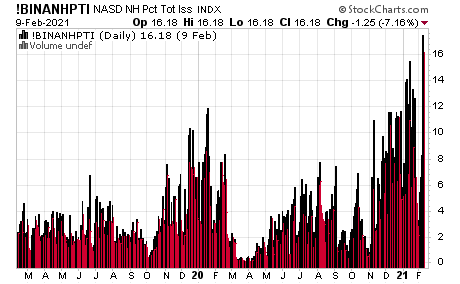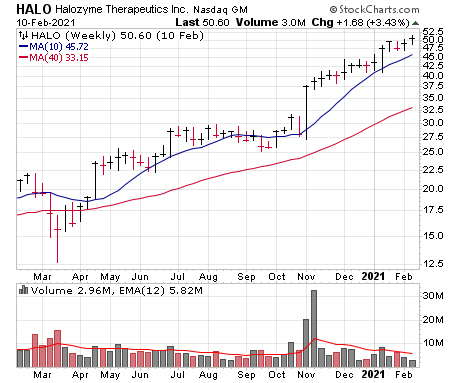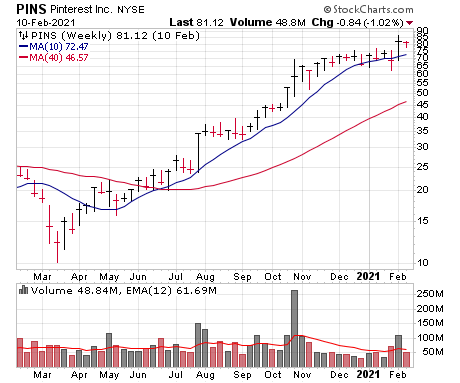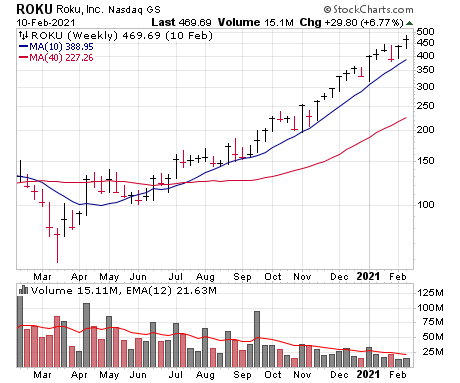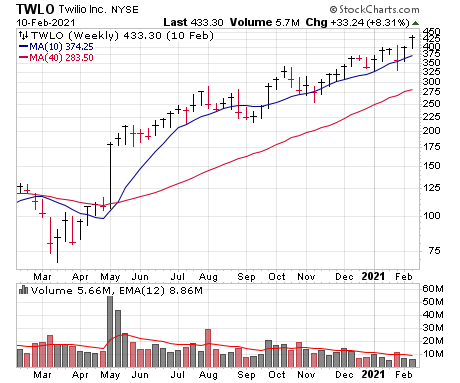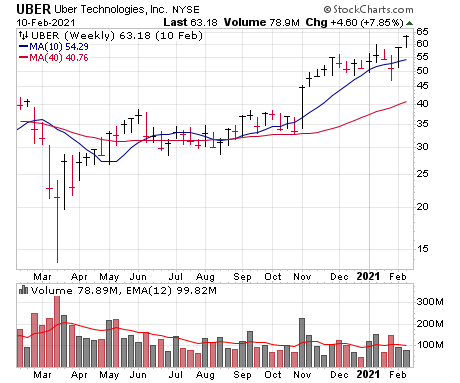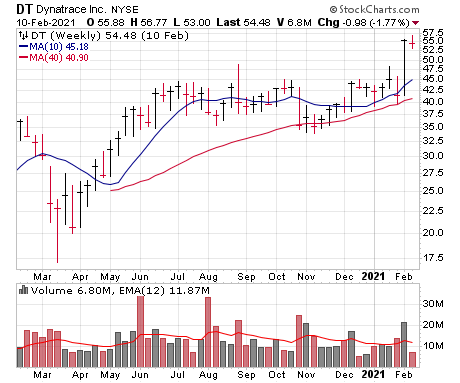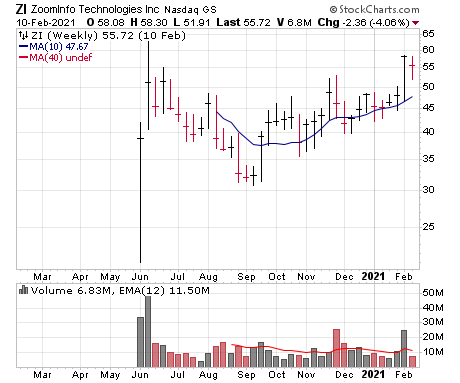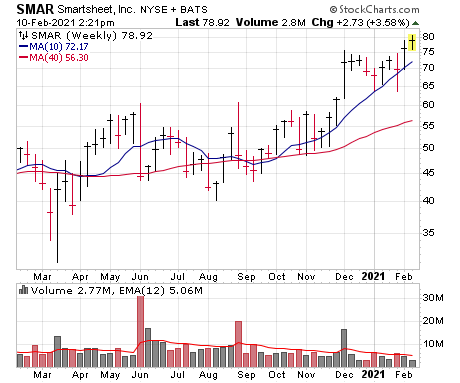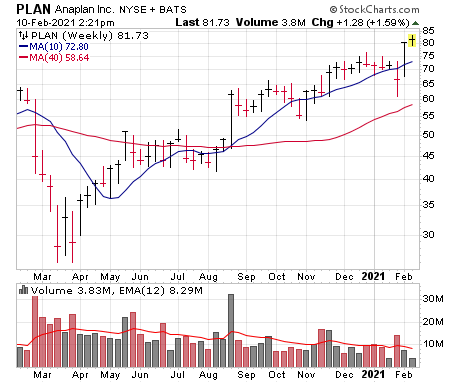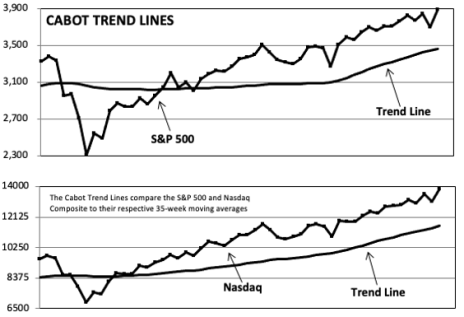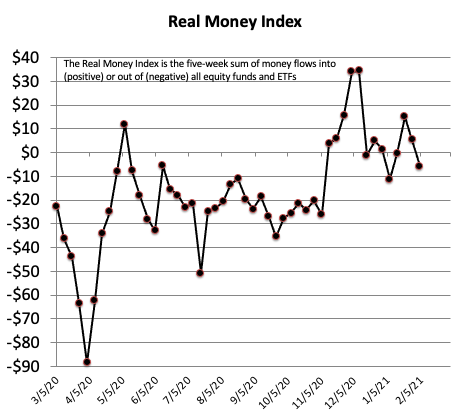Put simply, the market’s snapback from the selloff two weeks ago has been extremely impressive, and while it doesn’t erase all of the yellow flags, it’s certainly a positive sign. Because we didn’t drastically change our stance during the weakness (a little trimming), we’re not doing anything drastic during the rebound — at least not yet. We filled out our position in CrowdStrike last week and are placing Pinterest and Twilio back on Buy.
If all goes well, we could have a new addition or two soon, with our top choices written about in tonight’s issue. But tonight, we’ll stand pat and see how the market acts as earnings season continues.
Cabot Growth Investor 1465
[premium_html_toc post_id="225387"]
Simply Put: Very Impressive Action
Two weeks ago, the major indexes and some individual stocks began to flash abnormal action, a couple of key leaders were threatening to break down and some late-in-the-advance type of action (heavily shorted stocks going nuts) was occurring. Importantly, though, the primary evidence—the big-picture price, volume and trend action from the market and leading stocks—never cracked. Thus, we trimmed a bit, but thankfully didn’t let go of much stock.
And the action since then—really, it’s hard to have written a better script. Not only have the major indexes rebounded beautifully, but leading stocks have soared (many have exploded back to new highs), and even some of the aforementioned secondary evidence has wowed.
Look at the chart here of the number of new highs on the Nasdaq as a percent of issues traded: On Monday of this week, more than 17% of all Nasdaq stocks hit a new 52-week high, the second highest reading of the past 30 years! (Interestingly, the highest reading was in late 2016 near the start of that kickoff.) Moreover, a fair number of growth stocks that were sitting around for a few weeks suffered major shakeouts before their recent recoveries—generally a pattern that bodes well down the road.
Simply put, it’s very impressive and powerful action. As we frequently say, “up is good,” and we’re certainly seeing a lot of up lately. Thus, we remain bullish ...
... but, while the recent action has been very profitable and encouraging, we still think it’s important to pick your spots for a few reasons. The first is easy to understand: A ton of stocks are set to report earnings in the days ahead, so plowing in right ahead of those events is more like playing the roulette wheel or craps. Keep positions small if you are buying within two weeks of a quarterly report.
Beyond that, the rebound also hasn’t completely erased the worries that existed beforehand—sentiment remains elevated, few stocks are at great entry points (though maybe that changes as earnings season progresses) and the major indexes themselves are stretched to the upside. Even during this super-strong, post-election advance, when the indexes have become this stretched some sort of shakeout has followed.
What To Do Now
That’s not to say we’re not open to buying; in fact, there are two or three names that we may pull the trigger on soon if all goes well. But tonight, we’re going to stand pat with our current crop of strong stocks and a cash position of 20%. We’re are placing Pinterest and Twilio back on Buy.
Model Portfolio Update
The selloff in the market and leading growth stocks two weeks ago caused us to trim our sails a bit, cutting back on three positions and placing a couple others on hold. But soon after, the buyers returned! Despite the sales, the Model Portfolio itself has returned to new high ground, and we did a little buying last week, filling out our position in CrowdStrike (CRWD).
While we do think the dip-and-recovery action is bullish and may offer some high-odds entries, we also don’t see it as erasing the prior yellow flags (lots of crosscurrents, elevated sentiment, many names extended to the upside)—we’re happy to hang onto our stocks (most of which are performing very well) but we’re being discerning on the buy side, especially since earnings season is really ramping up now for many of the growth stocks we own or are stalking.
In tonight’s issue, we’re mostly standing pat, but we are restoring Buy ratings on both PINS and TWLO.
Current Recommendations
| Stock | No. of Shares | Portfolio Weightings | Price Bought | Date Bought | Price on 2/11/21 | Profit | Rating |
| CrowdStrike (CRWD) | 1,050 | 10% | 197 | 12/11/20 | 235 | 19% | Buy |
| Five Below (FIVE) | 852 | 7% | 138 | 9/18/20 | 188 | 37% | Hold |
| Halozyme (HALO) | 4,639 | 10% | 44 | 11/27/20 | 49 | 13% | Buy |
| Novocure (NVCR) | 1,335 | 10% | 142 | 11/6/20 | 183 | 29% | Buy |
| Pinterest (PINS) | 2,222 | 8% | 40 | 9/18/20 | 87 | 118% | Buy |
| ProShares Ultra S&P 500 (SSO) | 1,741 | 7% | 60 | 5/29/20 | 99 | 65% | Buy |
| Roku (ROKU) | 451 | 9% | 205 | 8/28/20 | 465 | 127% | Hold |
| Twilio (TWLO) | 553 | 10% | 174 | 5/8/20 | 433 | 149% | Buy |
| Uber (UBER) | 3,656 | 10% | 52 | 11/20/20 | 61 | 18% | Buy |
| CASH | $476,196 | 20% |
CrowdStrike (CRWD)—A recent industry survey showed that (a) security spending growth is set to accelerate in 2021, (b) 90%-plus of firms are dedicating more money toward cloud security solutions, and (c) CrowdStrike itself was cited as the leader in vulnerability management and as taking share on endpoint security. In a nutshell, there’s little standing in the way of this company getting much, much bigger over time. Of course, the company is not the stock, so we’re never complacent; our combined cost basis is just under 197, so some abnormal selling into the low/mid-180s (less than a 10% loss) could have us concluding something is off. But there’s no sign of that today—while the recent bounce has come on low volume, CRWD is perched near its all-time highs, and we’re putting more emphasis on the stock’s six-week rest and supporting action two weeks ago. We filled out our position last week and continue to think the next big move is up. BUY.
Five Below (FIVE)—As with a couple of our holdings, we may have been too conservative with Five Below, which has snapped back very nicely from the market’s recent lows, though, like many names, has done so on disappointing volume, which leaves it open to renewed selling (like we briefly saw yesterday). Fundamentally, one thing that popped into our heads is that the accelerating pace of vaccinations (now up to 1.5 million doses daily, up about 50% from a few weeks ago) could help investor perception that the world will turn right side up in due course. Back to the stock, the main trend is certainly up, and if FIVE can stabilize for a bit, we’ll likely restore our Buy rating. But at the moment, we’re going to stay on Hold, thinking more ups and downs are likely before another sustained rally. HOLD.
Halozyme (HALO)—HALO isn’t making any headlines, but the stock continues to look fine and make solid progress from its early-November coming out party. Moreover, it also has been avoiding the market’s wild action, trading relatively tightly, which is usually a constructive sign. One data source of ours says the firm will report Q4 results on February 23, though we can’t confirm that; either way, with Halozyme already pre-announcing Q4 numbers and its 2021 outlook, it likely won’t be a huge event for the stock. Another shakeout of two to four points wouldn’t shock us, especially if the market sags, but the story, numbers and chart are all lined up on the bull side. We’ll stay on Buy. BUY.
NovoCure (NVCR)—NVCR is one of many stocks that found logical support two weeks ago (near its 50-day line), raced higher with the market after that (zooming to new price highs out of a six-week range) but did so on light volume, which opens the door to some further wobbles. Still, the overall picture here remains bright, with earnings (coming on February 25) probably key—investors are clearly discounting not just solid growth in 2021 but some positive data regarding Optune later this year, so any tidbits on that (the company said that it should have Phase II data for Optune’s use in treating advanced liver cancer in Q1 of this year) would be revealing. Plus, of course, the 2021 outlook itself will carry weight. Right now, the evidence is bullish, so we’re sticking with a Buy rating, though new buyers should try to get in on dips of a few points from here. BUY.
Pinterest (PINS)—Pinterest continues to be rare merchandise, with a growth story that’s just a few months into getting going, yet is already delivering massive growth and attracting a slew of big investors. The Q4 report, released a week ago, was a barnburner—sales growth accelerated again (up 76%), earnings rose 258% and crushed expectations (43 cents vs 34 cents) while EBITDA grew nearly four-fold and monthly active users lifted 37% to a whopping 459 million (mostly overseas). All of that is a result of increasing and better content, improved advertising tools and making the platform as a whole more shoppable, but even bigger than that is the fact that Pinterest represents a unique opportunity for advertisers and merchants to get in front of potential buyers earlier in the process (while they’re coming up with ideas, as opposed to knowing what they want)—Pinterest is clearly capturing a big share of ad dollars that wants exposure to places outside Facebook and Google. Also helping sentiment were reports last night that Microsoft approached the company earlier this year to buy them, though most think that won’t go anywhere. Analysts tripped over themselves to up estimates after earnings (they now see 81 cents per share this year, up from a 65-cent estimate before the report), and PINS itself has popped to new highs. Maybe shares need some more time to consolidate in the near-term, but given the results and reaction, we think any weakness is likely to bring in support from institutions that are building positions in a hurry (1,073 funds now own shares, up from 537 just nine months ago!). If you own some, sit tight, and if you don’t, we’ll go back to Buy—you can enter around here. BUY.
ProShares Ultra S&P 500 Fund (SSO)—Often the first couple of times a stock or index tags its 50-day line during an intermediate-term advance brings in strong support, and that certainly was the case two weeks ago—the S&P 500 (and SSO) closed a smidge below that line on the last day of January but has motored to new highs since. As we wrote in the intro, this strong snapback is encouraging, but it doesn’t erase the yellow flags from before, such as elevated sentiment and the fact we’re three-plus months into the advance. That’s no reason to fight the trend (we never do that!), but some more volatility is a good bet in the weeks ahead. Looking down the road, if/when the Tides eventually turn negative, we’ll shift to Hold (and possibly shave off a few shares), but our goal continues to be to play SSO out for what we think is a larger, longer-term bull move. You can start a position here or (preferably) on dips. BUY.
Roku (ROKU)—ROKU continues to amaze, bursting to new highs earlier this week on big volume, completing its recovery from its dip to the 25-day line two weeks ago. Analysts continue to lift their price targets, citing the massive shift of ad money flowing from “regular” TV to over-the-top streaming platform’s like Roku’s, as well as the firm’s international potential (player unit sales doubled in Canada and the U.K. in Q3, while it launched the Roku Express player in Brazil last October), where it’s leading the streaming charge as well. We’re conflicted in terms of our rating—we’re certainly not trend fighters, and this is definitely one of the leading stocks of this bull move, so if you want to start a small position here, we’re not going to argue with you. Officially, though, we’ll stay on Hold, mostly because earnings are out a week from today (February 18), which, after a big run, could easily cause some near-term indigestion. HOLD.
Twilio (TWLO)—Near its lows two weeks ago, TWLO actually hadn’t made any net progress since early October, which did raise the prospect that the stock was losing its leadership qualities after such a big move from last spring. But it’s partially because of that (wearing/scaring out many weak hands) why the ensuing rebound looks so encouraging—the action since the low has been outstanding, with shares quickly rebounding to their prior highs and then blasting above the 400 level on a pickup in volume. Helping the cause was a strong upgrade yesterday, with one analyst effectively citing Twilio’s recent purchase of Segment, saying that CEOs are looking to the company for customer engagement help, not just with communications. Another underrated factor: Twilio has a big client base in industries like travel and leisure, both of which should surge later this year as the pandemic eases, while it also is doing good business in rapid-growth sectors like telehealth and medical. TWLO does report earnings next Wednesday (February 17), so we wouldn’t dive in here with both feet, but the shake-and-snapback action usually leads to good things. We’ll quickly restore our Buy rating, but new buyers should keep positions on the small side. BUY.
Uber (UBER)—UBER is another one of our stocks that staged a huge shakeout two weeks ago (retesting strong support in the upper 40s) and has bounded ahead since, scoring new highs this week. Interestingly, last night’s quarterly report was mixed—sales slipped 17% and actually missed expectations, while earnings and EBITDA were solidly in the red. Still, the stock continues to look great as investors are looking ahead: Bookings for the Rides segment continued to improve from the depths of the pandemic, with some areas (especially overseas) are actually approaching levels from a year ago. Meanwhile, the Delivery business continues to boom, with bookings up a whopping 128% from a year ago, helped along by new offerings (like grocery) and even the small freight business (just 2% of bookings but up 37% from last year) is doing well. Near-term, UBER could easily take a breather, but there’s little doubt business is headed much higher in 2021 and beyond, which should keep big investors interested. We’ll stay on Buy. BUY.
Watch List
- Anaplan (PLAN 81) and Smartsheet (SMAR 81): Cloud software names are showing signs of getting going, and these two look like possible new leaders. See more later in this issue.
- DraftKings (DKNG 59): DKNG has perked up to the top of its range while it continues to ink meaningful deals (including expanding its NFL fantasy agreement to Canada). Earnings are due out February 26.
- Dynatrace (DT 54): DT is a leader in one of our favorite themes (infrastructure and application performance monitoring) and after months of no progress, the stock has finally busted loose on the upside.
- Farfetch (FTCH 69): FTCH has perked up, though it remains choppy and the RP line is still working on a breakout. Earnings are due out February 25.
- Floor & Décor (FND 103): FND has been choppy, but the uptrend is still very much intact. Some calm action could be buyable.
- ZoomInfo (ZI 57): We’re very high on this relatively new issue (came public last June), as it checks just about all of the boxes we look for (story, numbers and now chart). See more below.
Other Stocks of Interest
Dynatrace (DT 54)—Fundamentally, we’re big fans of the infrastructure monitoring and application performance management space—with the huge migration of all things to the cloud, a complete platform that makes sure every piece of a client’s technology is working correctly (including whether customer experiences are up to snuff) is becoming a must-have. Some think it’s a $50 billion market opportunity! We’ve actually taken swings at both Dynatrace and Datadog (the top new-age players in these fields) over the past year, to no avail—but it’s possible the third time is the charm. Indeed, demand for Dynatrace’s all-in-one automated AI platform continues to pick up steam, and the firm’s own transition to a subscription-based model is paying big dividends: In last week’s Q4 report, sales (up 28%) and earnings (up 70%) easily topped expectations, while all the sub-metrics (annualized recurring revenue up 35%) pleased Wall Street. We especially like consistently growing recurring revenue metrics both for new deals ($111,000 on average, up 22%) and the average per customer overall ($251,000, up 20%). Despite a great story and numbers, DT had been range-bound last June, but big investors were looking ahead to better times (the number of funds owning shares was 723 at year-end, up from 329 nine months before!), and now shares are freewheeling after a powerful earnings gap last week. If the stock holds up a bit longer (especially if the market pulls in a bit), we could start a position in the Model Portfolio.
Peloton (PTON 146)—After the past year, Peloton really needs no introduction—it’s been one of the top handful of “pandemic” stocks, with business going to the moon as stay/work/workout-at-home trends picked up steam. Of course, the question is what happens to business (and investor perception) as the world turns right side up this year; there are doubters (north of 15 million shares short), but we think the company’s story can persist … and the stock may be nearing a good entry point, too. To us, the big idea here isn’t the pandemic, but a whole new industry: Connected fitness is still early in its growth phase, and while the virus definitely helped, we see no reason why most who can afford it won’t choose to get a high-quality workout at home, rather than having to hop in the car and drive 15 minutes to the gym. Indeed, this quote from Peloton’s CEO in last week’s Q4 conference call is noteworthy: “When the vaccine was announced in the fall, you saw a reaction in the stock, but we did not see any reaction to our sales or demand. We still have not seen any softening since that vaccine was announced and rolling out.” With new services and offerings, and with recurring revenue a huge factor here ($40 per month for everything, and even if you don’t have their bike or treadmill, you can pay $13 per month for access to dozens of classes on their app), the sky’s the limit. Obviously, a lot of good news has been discounted, and yes, growth will surely slow from last year’s torrid pace (sales up 128% in Q4), but years of rapid expansion (and booming earnings) are likely upcoming. Moreover, the stock doesn’t look like it’s done for—after its massive-volume advance to 140 last October, PTON has etched a base-on-base pattern (no net progress for four months), with little meaningful distribution during that time. It’s possible PTON fails, but we think a strong few days could kick off the next meaningful advance.
ZoomInfo (ZI 57)—There are no sure things in the market, but ZoomInfo checks just about all of the boxes we look for when searching for a new leader. The company has the feel of a young Salesforce.com, with a unique offering that is looking like the next big thing in customer relationship management (CRM) solutions. The big idea here is that CRM data are normally populated from lead generation activities, which was fine years ago but these days gets quickly out of date, resulting in salespeople spending a lot of their time doing stuff besides actually selling (such as gathering and entering data to figure out if a firm is a potential customer). ZoomInfo, on the other hand, has a much better way—its “Go-to-Market Intelligence” platform uses AI and machine learning of various publicly available data (along with information sharing among customers) to dynamically update its platform, which means it can do a lot of the legwork (rank best targets, present direct contact info) and let salespeople do what they do best. ZoomInfo’s offering is integrated into many big sales offerings (including Salesforce, HubSpot, Marketo, Oracle and Microsoft Dynamics), and thanks to the scale of its data collection efforts (50 million contact record events daily, 50 million web domains monitored) and coverage of potential sales targets (up to 100 million businesses!), we think it’ll stay firmly in the lead. Not surprisingly, the numbers look great, with sales up 56% in Q3 and earnings in the black for three straight quarters, and analysts see more of where that came from this year (sales up 30%, earnings up 47%, both of which are likely conservative). We wrote about the stock on this page seven months ago when it was a young IPO, but it needed some more seasoning and spent the ensuing period rounding out a big post-IPO base. But last week was noteworthy—ZI popped to its highest weekly close ever on a bunch of big-volume days of buying. Earnings are out February 22, and the valuation is a bit up there ($22 billion market cap vs. revenue run rate of $500 million), but we really like the story and the look of the chart. ZI is high on our watch list.
Cloud Software: Ready for Another Run?
Cloud software stocks have been in a long-term uptrend for the past three years, and we think that strength can continue for a long time to come—much of the business world’s enterprise software is being switched over from old-school, on-premise solutions to cloud offerings that boost productivity in a big way. And even among cloud vendors, there are all sorts of innovations going on in specific industries that make software developed five or six years ago look out of date.
Throw in the fact that most players use a subscription business model (leading to more reliable growth) and the cloud software area is likely still in the middle innings of its long-term advance. However, that doesn’t mean the stocks are always headed higher—indeed, the sector has had numerous multi-month rest periods over time, and when they end, it’s not unusual to see some of the old guard (think Salesforce.com or Workday) pass the leadership baton to newer, more dynamic companies with newer, more dynamic offerings.
Today, we’re seeing signs the group is beginning to flex its muscle after one of those long rests—while some names have done well, relative to the market, the group has been mostly chopping around since last summer. And true to form, we’re seeing some fresher names that are in pole position to lead the upmove—and, interestingly, both involve allowing clients to better plan and execute large projects.
One is Smartsheet (SMAR), which is a name we’ve mentioned in the past. The big idea here is that more than half of all work these days doesn’t necessarily fit into one of the typical solutions out there (resource planning, customer relationships, IT management, etc.)—instead, processes are cobbled together by emails and off-the-cuff decisions. That can be fine, but it usually leads to lower productivity and eliminates a possibility of real-time collaboration.
Smartsheet’s solution fills that gap, able to add structure and organization to a variety of workflows, with prebuilt forms to collect information in a standardized way and automatically add it to a sheet that’s shared with whoever needs to see it. Long story short, Smartsheet allows tons of departments to take the tidal wave of weekly requests that come up and process them efficiently, something that’s doubly important as more work is done outside the office.
The company’s growth did slow down a touch late last year due to the pandemic, but sales growth remained solid (up 38% in Q3) and even with some issues striking new deals, the sub-metrics have remained bullish (same-customer revenue growth of 25%). SMAR soared after that Q3 report to new price highs, but the long-term RP line didn’t quite make it and the group still wasn’t in gear. The result: A fresh, tighter six-week launching pad that has given way to a breakout attempt this week.
The other fresher name we like is Anaplan (PLAN), which, like Smartsheet, has been on our watch list before. As the symbol suggests, the big idea is the firm’s cloud-based business planning platform, helping managers in tons of industries and departments gain better visibility (and make better decisions) when looking ahead. But the real secret sauce here looks to be Anaplan’s scenario planning engine dubbed Hyperblock (shows all the effects and details of any change in a plan, which in turn allows for rapid, detailed modeling) and its PlanIQ system, which uses AI and machine learning to better forecast results.
The numbers here aren’t quite as good as Smartsheet’s (sales up 28% in Q3; same-customer revenue growth of 13%), but it’s building a huge long-term backlog (total value under contract $740 million, up 25%), is capturing more large customers and saw its billings growth accelerate after a Q2 slowdown. The stock has been gradually pushing higher in recent months, but the shakeout two weeks ago and huge snapback to new highs could be a sign it’s ready to move. Earnings are due out February 25.
Both SMAR and PLAN smell like newer leaders that are just getting going from year-plus-long consolidations—they’re on our watch list, and if the cloud software group kicks into gear, we’re optimistic both can do well.
Cabot Market Timing Indicators
The market’s strong snapback from the short-selling maelstrom of two weeks ago is very encouraging, keeping both our trend-following measures solidly positive and helping most individual stocks. That said, it doesn’t erase some of the prior yellow flags, so we’re holding our strong names but picking our spots on the buy side.
Cabot Trend Lines: Bullish
Our Cabot Trend Lines remain both clearly bullish and clearly extended—after last week’s giant rebound, the S&P 500 (by more than 12%) and Nasdaq (by nearly 20%!) stood miles above their respective 35-week moving averages. There’s nothing new to report here: The larger, longer-term bull market is firmly intact, but risk is elevated that we’ll see further shakeouts or rest periods to close the gaps between the indexes and moving averages.
Cabot Tides: Bullish
Our Cabot Tides came close to the edge during the selloff two weeks ago, but the market passed that test with flying colors—all five indexes we track (including the S&P 500, daily chart shown here) are not only nicely above their lower (50-day) moving averages, but have also reached new high ground in recent days. Pullbacks are possible, of course, but with the intermediate- and longer-term trends pointed up, it’s best to remain mostly bullish.
Cabot Real Money Index: Neutral
Our Real Money Index has pulled in a bit, and encouragingly, investors did get nervous after the market’s recent GameStop-induced wobble—$11 billion whooshed out of equity funds and ETFs last week, a good-sized show of short-term fear. Still, on a five-week basis, money flow remains more neutral than anything.
Charts courtesy of StockCharts.com
The next Cabot Growth Investor issue will be published on February 25, 2021.
Cabot Wealth Network
Publishing independent investment advice since 1970.
President & CEO: Ed Coburn
Chairman & Chief Investment Strategist: Timothy Lutts
176 North Street, PO Box 2049, Salem, MA 01970 USA
800-326-8826 | support@cabotwealth.com | CabotWealth.com
Copyright © 2021. All rights reserved. Copying or electronic transmission of this information is a violation of copyright law. For the protection of our subscribers, copyright violations will result in immediate termination of all subscriptions without refund. No Conflicts: Cabot Wealth Network exists to serve you, our readers. We derive 100% of our revenue, or close to it, from selling subscriptions to its publications. Neither Cabot Wealth Network nor our employees are compensated in any way by the companies whose stocks we recommend or providers of associated financial services. Disclaimer: Sources of information are believed to be reliable but they are not guaranteed to be complete or error-free. Recommendations, opinions or suggestions are given with the understanding that subscribers acting on information assume all risks involved. Buy/Sell Recommendations: All recommendations are made in regular issues or email alerts or updates and posted on the private subscriber web page. Performance: The performance of this portfolio is determined using the midpoint of the high and low on the day following the recommendation. Cabot’s policy is to sell any stock that shows a loss of 20% in a bull market or 15% in a bear market from the original purchase price, calculated using the current closing price. Subscribers should apply loss limits based on their own personal purchase prices.

